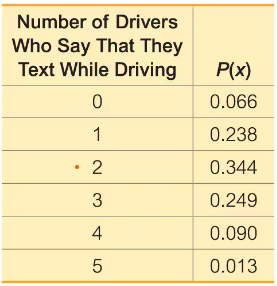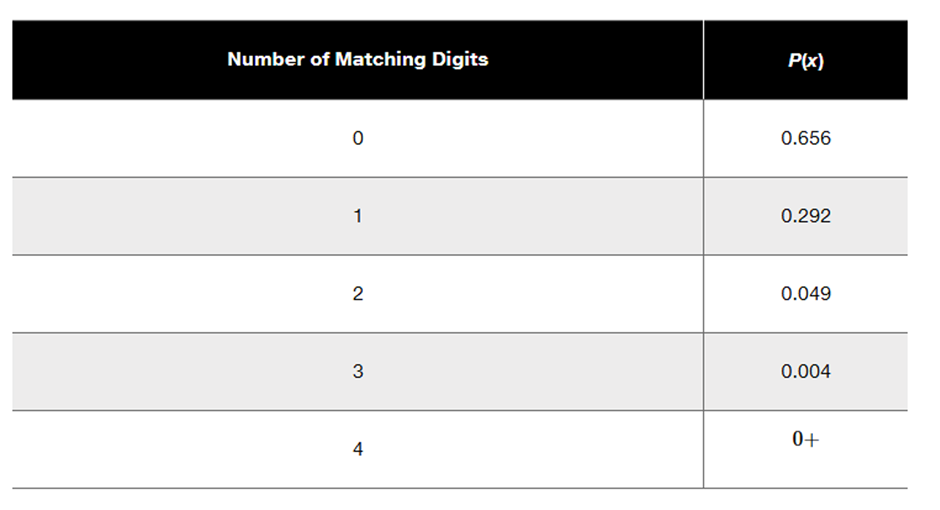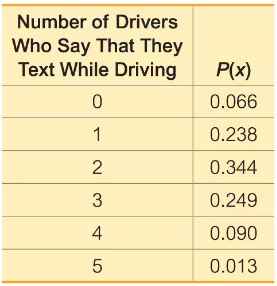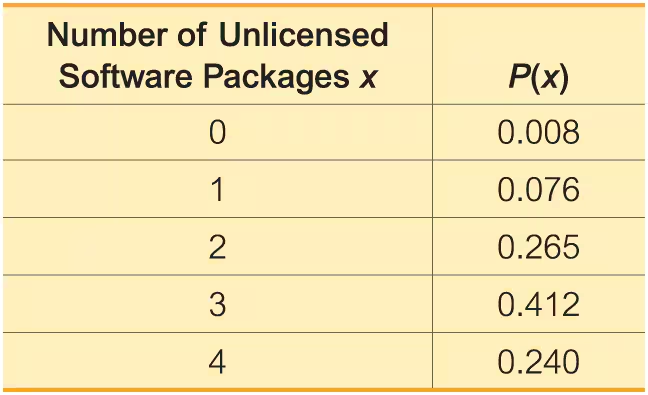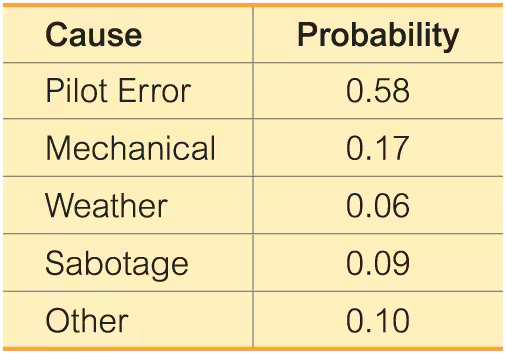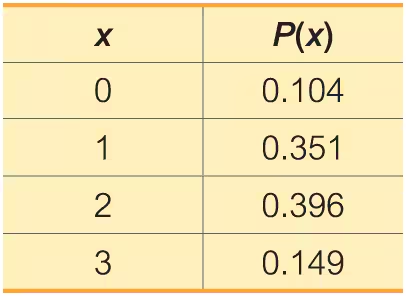 Back
BackProblem 5.R.10b
Poisson: Deaths Currently, an average of 7 residents of the village of Westport (population 760) die each year (based on data from the U.S. National Center for Health Statistics).
b. Find the probability that on a given day, there are no deaths.
Problem 5.R.10c
Poisson: Deaths Currently, an average of 7 residents of the village of Westport (population 760) die each year (based on data from the U.S. National Center for Health Statistics).
c. Find the probability that on a given day, there is more than one death.
Problem 5a
In Exercises 5–8, assume that the Poisson distribution applies; assume that the mean number of Atlantic hurricanes in the United States is 5.5 per year, as in Example 1; and proceed to find the indicated probability.
Hurricanes
a. Find the probability that in a year, there will be 7 hurricanes.
Problem 5b
In Exercises 5–8, assume that the Poisson distribution applies; assume that the mean number of Atlantic hurricanes in the United States is 5.5 per year, as in Example 1; and proceed to find the indicated probability.
Hurricanes
b. In a 118-year period, how many years are expected to have 7 hurricanes?
Problem 5.1.24
Texting and Driving. In Exercises 21–26, refer to the accompanying table, which describes probabilities for groups of five drivers. The random variable x is the number of drivers in a group who say that they text while driving (based on data from an Arity survey of drivers).
Using Probabilities for Significant Events
a. Find the probability of getting exactly 3 drivers who say that they text while driving.
Problem 5.1.29b
Expected Value for the Florida Pick 3 Lottery In the Florida Pick 3 lottery, you can bet $1 by selecting three digits, each between 0 and 9 inclusive. If the same three numbers are drawn in the same order, you win and collect $500.
b. What is the probability of winning?
Problem 5.1.30a
Expected Value in North Carolina’s Pick 4 Game In North Carolina’s Pick 4 lottery game, you can pay $1 to select a four-digit number from 0000 through 9999. If you select the same sequence of four digits that are drawn, you win and collect $5000.
a. How many different selections are possible?
Problem 5.1.4
Significant For 100 births, P(exactly 56 girls) and P(56 or more girls) Is 56 girls in 100 births a significantly high number of girls? Which probability is relevant to answering that question?
Problem 5.1.17
Lottery. In Exercises 15–20, refer to the accompanying table, which describes probabilities for the California Daily 4 lottery. The player selects four digits with repetition allowed, and the random variable x is the number of digits that match those in the same order that they are drawn (for a “straight” bet).
Range Rule of Thumb for Significant Events Use the range rule of thumb to determine whether 4 matches is a significantly high number of matches.
Problem 5.1.18a
Lottery. In Exercises 15–20, refer to the accompanying table, which describes probabilities for the California Daily 4 lottery. The player selects four digits with repetition allowed, and the random variable x is the number of digits that match those in the same order that they are drawn (for a “straight” bet).
Using Probabilities for Significant Events
a. Find the probability of getting exactly 2 matches.
Problem 5.1.18b
Lottery. In Exercises 15–20, refer to the accompanying table, which describes probabilities for the California Daily 4 lottery. The player selects four digits with repetition allowed, and the random variable x is the number of digits that match those in the same order that they are drawn (for a “straight” bet).
Using Probabilities for Significant Events
b. Find the probability of getting 2 or more matches.
Problem 5.1.19a
Lottery. In Exercises 15–20, refer to the accompanying table, which describes probabilities for the California Daily 4 lottery. The player selects four digits with repetition allowed, and the random variable x is the number of digits that match those in the same order that they are drawn (for a “straight” bet).
Using Probabilities for Significant Events
a. Find the probability of getting exactly 3 matches.
Problem 5.1.19b
Lottery. In Exercises 15–20, refer to the accompanying table, which describes probabilities for the California Daily 4 lottery. The player selects four digits with repetition allowed, and the random variable x is the number of digits that match those in the same order that they are drawn (for a “straight” bet).
Using Probabilities for Significant Events
b. Find the probability of getting 3 or more matches.
Problem 5.1.22
Texting and Driving. In Exercises 21–26, refer to the accompanying table, which describes probabilities for groups of five drivers. The random variable x is the number of drivers in a group who say that they text while driving (based on data from an Arity survey of drivers).
Range Rule of Thumb for Significant Events Use the range rule of thumb to determine whether 4 is a significantly high number of drivers who say that they text while driving.
Problem 5.1.19c
Using Probabilities for Significant Events
c. Which probability is relevant for determining whether 3 is a significantly high number of matches: the result from part (a) or part (b)?
Problem 5.1.20a
Using Probabilities for Significant Events
a. Find the probability of getting exactly 1 match.
Problem 5.1.20b
Using Probabilities for Significant Events
b. Find the probability of getting 1 or fewer matches.
Problem 5.1.20c
Using Probabilities for Significant Events
c. Which probability is relevant for determining whether 1 is a significantly low number of matches: the result from part (a) or part (b)?
Problem 5.1.20d
Using Probabilities for Significant Events
d. Is 1 a significantly low number of matches? Why or why not?
Problem 5.1.27
Biometric Security In a USA Today survey of 510 people, 270 (or 53%) said that we should replace passwords with biometric security, such as fingerprints. Use the following probabilities related to determining whether the result of 270 is significantly high (assuming the true rate is 50%). Is 270 significantly high? What should be concluded about the claim that the majority of the population says that we should replace passwords with biometric security? Explain.
Problem 5.1.1
Random Variable The accompanying table lists probabilities for the corresponding numbers of unlicensed software packages when four software packages are randomly selected in China. What is the random variable, what are its possible values, and are its values numerical?
Problem 5.1.5
Identifying Discrete and Continuous Random Variables. In Exercises 5 and 6, refer to the given values, then identify which of the following is most appropriate: discrete random variable, continuous random variable, or not a random variable.
a. IQ scores of statistics students
b. Exact heights of statistics students
c. Shoe sizes (such as 8 or 8½) of statistics students
d. Majors (such as history) of statistics students
e. The number of rolls of a die required for a statistics student to get the number 4
Problem 5.1.28
Stem Cell Survey In a Newsweek poll of 882 adults, 481 (or 55%) said that they were in favor of using federal tax money to fund medical research using stem cells obtained from human embryos. A politician claims that people don’t really understand the stem cell issue and their responses to such questions are random responses equivalent to a coin toss. Use the following probabilities related to determining whether the result of 481 is significantly high (assuming the true rate is 50%). Is 481 significantly high? What should be concluded about the politician’s claim? Explain.
P(respondent says to use the federal tax money) = 0.5
P(among 882, exactly 481 says to use federal tax money) = 0.000713
P(among 882,481 or more say to use federal tax money) = 0.00389
Problem 5.1.29d
Expected Value for the Florida Pick 3 Lottery In the Florida Pick 3 lottery, you can bet $1 by selecting three digits, each between 0 and 9 inclusive. If the same three numbers are drawn in the same order, you win and collect $500.
d. Find the expected value for a $1 bet.
Problem 5.1.30d
Expected Value in North Carolina’s Pick 4 Game In North Carolina’s Pick 4 lottery game, you can pay $1 to select a four-digit number from 0000 through 9999. If you select the same sequence of four digits that are drawn, you win and collect $5000.
d. Find the expected value.
Problem 5.1.30e
Expected Value in North Carolina’s Pick 4 Game In North Carolina’s Pick 4 lottery game, you can pay $1 to select a four-digit number from 0000 through 9999. If you select the same sequence of four digits that are drawn, you win and collect $5000.
e. If you bet $1 in North Carolina’s Pick 3 game, the expected value is Which bet is better in the sense of a producing a higher expected value: A $1 bet in the North Carolina Pick 4 game or a $1 bet in the North Carolina Pick 3 game?
Problem 5.1.2
Discrete or Continuous? Is the random variable given in the table from Exercise 1 discrete or continuous? Explain.
Problem 5.1.7
Identifying Probability Distributions. In Exercises 7–14, determine whether a probability distribution is given. If a probability distribution is given, find its mean and standard deviation. If a probability distribution is not given, identify the requirements that are not satisfied.
Plane Crashes The table lists causes of fatal plane crashes with their corresponding probabilities.
Problem 5.1.9
Identifying Probability Distributions. In Exercises 7–14, determine whether a probability distribution is given. If a probability distribution is given, find its mean and standard deviation. If a probability distribution is not given, identify the requirements that are not satisfied.
Online Courses College students are randomly selected and arranged in groups of three. The random variable x is the number in the group who say that they take one or more online courses (based on data from Sallie Mae).
Problem 5.1.12
Identifying Probability Distributions. In Exercises 7–14, determine whether a probability distribution is given. If a probability distribution is given, find its mean and standard deviation. If a probability distribution is not given, identify the requirements that are not satisfied.
Fear of Heights The table lists results from a survey of 285 subjects who were asked, “Are you afraid of heights in tall buildings?” The results are from USA Today.

